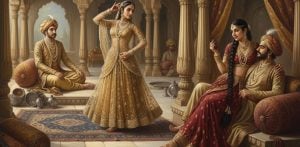His name continues to inspire patriotism.
Mangal Pandey is more than a soldier – he remains one of the most culturally significant figures in Indian history.
Long before Mahatma Gandhi began his quest for an independent India, Pandey fought with rebellion and determination blazing in his eyes.
He played an undeniable role in the Indian Rebellion of 1857, which ultimately led to the collapse of the East India Company, which had arrived in the 18th century.
A sepoy, a freedom fighter, and a symbol of courage, Mangal Pandey’s saga has inspired many texts and media in India.
He accomplished great feats in a short life. Paying tribute to him, we invite you on an exciting journey as we explore the life of a legend.
Early Life & Military Service
 Born in 1827 in Nagwa, a village in present-day Uttar Pradesh, Mangal Pandey joined the Bengal Army of the British East India Company in 1849.
Born in 1827 in Nagwa, a village in present-day Uttar Pradesh, Mangal Pandey joined the Bengal Army of the British East India Company in 1849.
His military career placed him among thousands of Indian sepoys serving under British rule.
Over time, growing resentment against oppressive policies and cultural insensitivity fuelled unrest among the rebellious soldiers.
Pandey was known for his discipline and dedication, but the increasingly discriminatory policies of the British Empire left many Indian soldiers disillusioned.
Heavy taxation, economic exploitation, and the Doctrine of Lapse were further fuelling the discontent.
The sepoys, who were primarily Hindu and Muslim, felt alienated due to policies that seemed designed to undermine their cultural and religious identities.
The Catalyst of the Sepoy Mutiny
 The immediate cause of the Sepoy Mutiny was the introduction of the Enfield P-53 rifle.
The immediate cause of the Sepoy Mutiny was the introduction of the Enfield P-53 rifle.
The cartridges were rumoured to be greased with cow and pig fat—an insult to both Hindu and Muslim soldiers.
The British Raj’s dismissal of concerns surrounding this issue led to heightened tensions.
On March 29, 1857, at the Barrackpore cantonment, Mangal Pandey openly rebelled against British officers, attacking them in a fit of nationalist fervour.
He urged fellow soldiers to join him, marking the beginning of open defiance.
Despite his efforts, Pandey was overpowered and arrested.
This event sent shockwaves across India, as Mangal Pandey’s resistance symbolised the growing discontent among Indian soldiers.
The British viewed him as a traitor, but for many Indians, he became a symbol of resistance against colonial oppression.
His act of rebellion demonstrated the frustration of Indian soldiers, who felt betrayed and dehumanised by the British officers.
Role in the Indian Rebellion of 1857
 Though Pandey’s individual act was short-lived, his actions resonated across India.
Though Pandey’s individual act was short-lived, his actions resonated across India.
The mutiny spread from Meerut to Delhi, Kanpur, and beyond, with Indian soldiers rebelling against British rule.
This uprising evolved into the Indian Rebellion of 1857, which remains a pivotal event in Indian history.
The uprising saw Indian soldiers, landlords, and common people coming together to challenge British rule.
While it was ultimately suppressed, it marked the first large-scale resistance against colonialism.
The rebellion exposed the weaknesses of the British administration and forced them to rethink their policies in India.
Historians often debate whether Mangal Pandey acted alone or as part of a larger conspiracy, but his act of defiance undoubtedly served as a catalyst.
His refusal to accept British hegemony inspired future generations to continue the fight for independence.
Trial & Execution
 Following his arrest, Mangal Pandey was court-martialled.
Following his arrest, Mangal Pandey was court-martialled.
The British authorities sentenced him to death on April 6, 1857, expediting the execution to quell the growing unrest.
He was hanged at Barrackpore, but his martyrdom inspired thousands to resist colonial oppression.
Pandey’s execution was meant to serve as a warning to other rebellious soldiers.
However, instead of suppressing the unrest, it further ignited anger against the British administration.
His trial was swift, and the lack of due process indicated the British Empire’s desperation to suppress any sign of rebellion.
Mangal Pandey: The Rising (2005)
 Ketan Mehta’s 2005 film Mangal Pandey: The Rising brought his story to a global audience.
Ketan Mehta’s 2005 film Mangal Pandey: The Rising brought his story to a global audience.
Starring Aamir Khan as the titular rebel, the film portrayed Pandey’s life, his resistance, and the larger political context of the time.
The movie reignited interest in his heroic legacy, further establishing him as a cultural icon.
The film depicted the emotions, betrayal, and nationalist fervour that defined Pandey’s era.
While some aspects of the story were dramatised, it successfully captured the essence of his struggle.
It played a significant role in reintroducing his story to modern audiences, especially the youth, ensuring that his sacrifice was not forgotten.
Unfortunately, the film did not do too well at the box office but Aamir’s performance and the message are still praised by the audience.
The Legacy of Mangal Pandey
 Mangal Pandey’s influence on Indian nationalism is undeniable.
Mangal Pandey’s influence on Indian nationalism is undeniable.
His name is synonymous with the revolutionary spirit that paved the way for India’s eventual independence.
Pandey is celebrated through literature, cinema, and public memory, standing tall among the most revered historical figures in the fight against the British Raj.
Several institutions, roads, and parks across India have been named after him.
Statues and memorials dedicated to him stand as reminders of his bravery.
His name has become synonymous with resistance and courage, inspiring numerous freedom movements across the world.
His story is taught in history books, ensuring that young Indians learn about his role in the fight against British rule.
Folk songs, plays, and regional literature have kept his legacy alive, portraying him as a martyr who laid the foundation for India’s independence movement.
Many revolutionaries who followed, including Bhagat Singh and Subhas Chandra Bose, drew inspiration from his defiance.
His legacy extends beyond history, shaping the cultural identity of India.
Mangal Pandey’s actions may have lasted mere moments, but their impact reverberated through history.
His fearless defiance of British rule set the stage for India’s struggle for independence.
As a freedom fighter, his name continues to inspire patriotism, reminding Indians of the sacrifices made to reclaim their sovereignty.
His legacy is not just that of rebellion but of awakening. His sacrifice reminds people that courage in the face of oppression can spark change.
Though Mangal Pandey did not live to see an independent India, his actions played an integral role in shaping its destiny.






























































